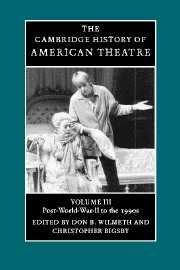Book contents
- Frontmatter
- Introduction
- Timeline: Post-World War II to 1998
- 1 American Theatre in Context: 1945–Present
- 2 A Changing Theatre: Broadway to the Regions
- 3 The Plays and Playwrights
- 4 Musical Theatre since World War II
- 5 Directors and Direction
- 6 Actors and Acting
- 7 American Theatre Design Since 1945
- Bibliography
- Index
4 - Musical Theatre since World War II
Published online by Cambridge University Press: 28 March 2008
- Frontmatter
- Introduction
- Timeline: Post-World War II to 1998
- 1 American Theatre in Context: 1945–Present
- 2 A Changing Theatre: Broadway to the Regions
- 3 The Plays and Playwrights
- 4 Musical Theatre since World War II
- 5 Directors and Direction
- 6 Actors and Acting
- 7 American Theatre Design Since 1945
- Bibliography
- Index
Summary
Prelude
World War II was the crucible from which most of the trends of the twenty years following the war developed. The post-Depression economic boom, and the fact that New York was a major point of both embarkation and recreational leave for American servicemen, pumped much-needed dollars into the theatre and gave rise to long runs that surpassed all earlier eras, as well as a rebirth of that most topical of music-theatre forms, the revue. Indeed, the seeds of virtually all of the major trends in the musical theatre after the war can be seen in the attractions offered during 1943 and 1944. Rodgers and Hammerstein’s Oklahoma!, often heralded as the beginning of the modern “musical play,” opened in 1943 (see Volume 2’s coverage of pre-1945 Rodgers and Hammerstein). At the same time, such unabashedly old-fashioned musicals as Cole Porter’s Mexican Hayride and the vaudeville-burlesque-flavored Follow the Girls, both major hits of 1944, showed that there was plenty of life in the old forms. 1944 also saw the first of the major choreographer-conceived dance musicals, On the Town, and the dawning of a new social consciousness in Bloomer Girl. Nostalgia for an earlier, more simple era also led to revivals of older operettas (The Student Prince, The Merry Widow), as well as the rise of such “new” old-fashioned operettas as 1944’s Song of Norway. This was the picture as the musical theatre entered the postwar period in 1945.
- Type
- Chapter
- Information
- The Cambridge History of American Theatre , pp. 419 - 465Publisher: Cambridge University PressPrint publication year: 2000



